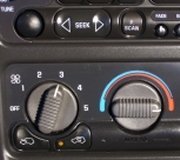Hi JBiggs82 andwelcome to 2carpros
Misfire at no.2 cyl-check the sparkplug/compression/injector for this cylinder
Lack of heat
When no or low heater output is not due to a blower problem (plenty of air coming out of the ducts but the air isn't hot), the list of possible causes include:
Blocked circulation through the heater core - due to either sediment in the core or a defective heater control valve. Feel the heater inlet and outlet hoses while the engine is idling and warm, and the heater temperature control is on hot. The hose will not feel hot on the heater side of the valve if the valve is shut. The outlet hose will also not be hot.
With cable-operated control valves, check the cable for sticking, slipping (loose mounting bracket) or misadjustment. With valves that are vacuum operated, there should be no vacuum to the valve when the heater is on (except for those that are normally closed and need vacuum to open). Someone may have misrouted a vacuum hose.
With electronic heater control valves, check for voltage at the valve. It should have voltage when the temperature controls are set for maximum heat. If the solenoid fails to move when voltage is applied, it is defective and needs to be replaced.
If the heater core appears to be plugged, the inlet hose may feel hot up to the core but the outlet hose will remain cool. Reverse-flushing the core (forcing water into the heater outlet pipe with a garden hose) can sometimes open up a blockage, but usually the core will have to be removed for cleaning or replacement.
Air pockets in the heater core also can interfere with proper coolant circulation. It's akin to losing the prime with a siphon pump. Air pockets form when the coolant level is low or when the cooling system is not properly filled after draining.
Low coolant level - usually the result of overheating or a coolant leak. A low coolant level can starve the heater resulting in little or no heat output. To check the level, pay no attention to the overflow reservoir. Shut the engine off, wait 20 minutes or so for the engine to cool, then carefully open the radiator cap. Allow any residual pressure to vent itself completely before removing the cap. If the coolant level inside the radiator is low, adding coolant won't fix the problem if there's a leak. Inspect the water pump, hose connections, radiator and engine for coolant leaks. Also pressure-test the cooling system and radiator cap to check for internal coolant leaks due to a bad head gasket or cracks in the cylinder head. Check the pressure rating on the cap to see that it's correct for the application, and carefully inspect the cap's gasket and spring. Replace the cap if it can't hold its rated pressure or has the wrong pressure rating for the application.
Cooling system neglect can allow internal corrosion to eat small holes in the heater core or where the pipes are soldered to the end tank. Leaks also can be caused by sediment circulating in the cooling system. Sediment is abrasive and will literally wear holes in the heater core.
A leaky core will often drip coolant into the passenger compartment (don't confuse this with water condensation that may be coming from the A/C evaporator). Leaks also can develop from fatigue cracks in the inlet and outlet pipes. This is caused by flexing of the heater hoses from engine torque and/or vibration.
Adding sealer to the cooling system may provide a temporary fix, but the long-term cure is to replace the heater core.
Defective or missing thermostat that allows the engine to run too cool. Maintaining the correct engine operating temperature (usually 200 to 220 degrees F.) Is essential not only for good heater output but also for good fuel mileage and proper operation of various emissions control functions. If the temperature gauge on the dash reads low, the engine is slow to warm up or you can feel coolant rushing through the upper radiator hose when the engine is cold started, the thermostat is stuck open (or missing) and needs to be replaced. Be sure to install a thermostat that's rated at the same temperature as the original (usually 195 degrees on late-model cars).
A weak water pump that fails to circulate an adequate amount of coolant to the heater. This problem also will cause the engine to overheat. If the problem isn't due to a slipping drive belt, the pump probably has an eroded or separated impeller
SPONSORED LINKS
Thursday, October 23rd, 2008 AT 3:36 PM




